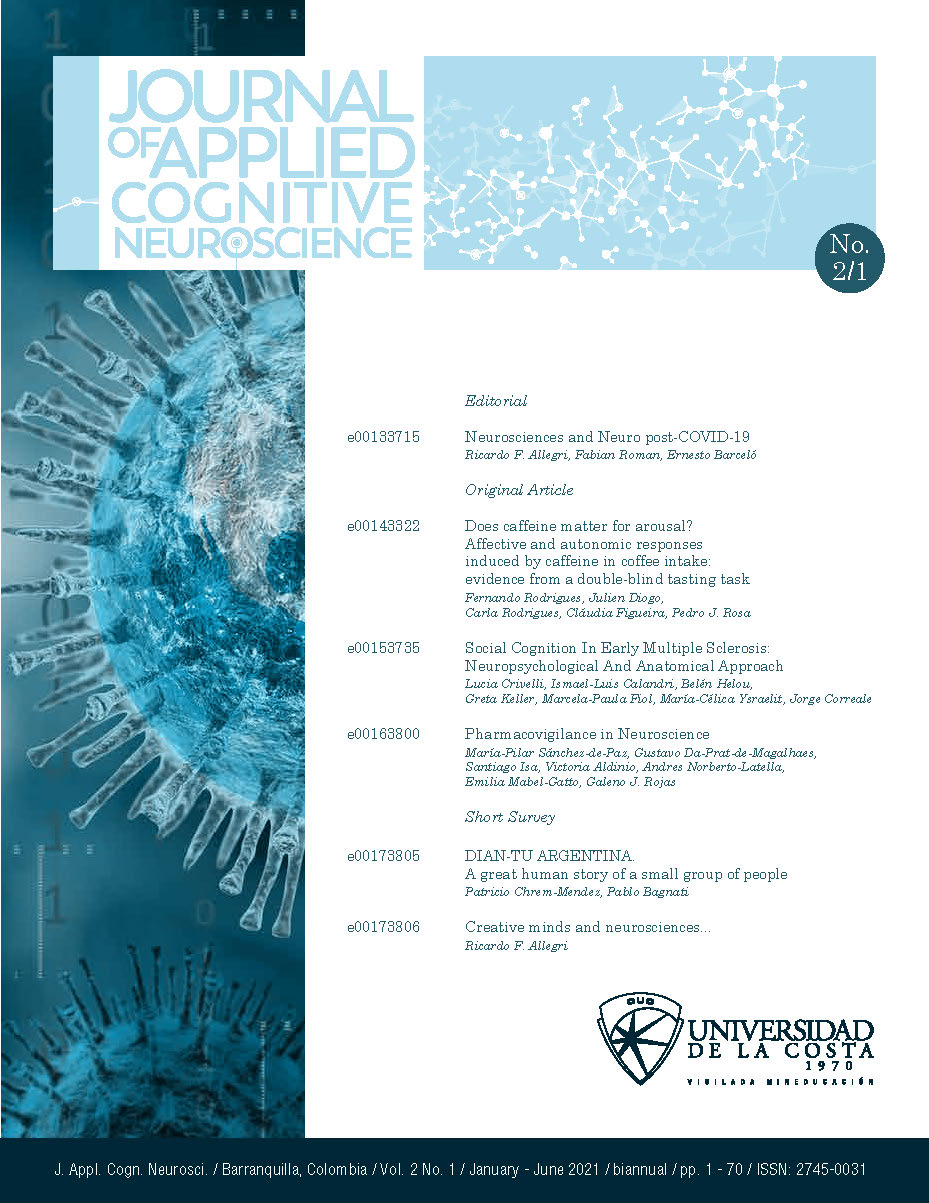La Cognición Social en la Esclerosis Múltiple Temprana: Enfoque neuropsicológico y anatómico
Cognición Social En La Esclerosis Múltiple Temprana: Enfoque Neuropsicológico Y Anatómico
DOI:
https://doi.org/10.17981/JACN.2.1.2021.03Palabras clave:
Cognitive Dysfunction, Social Cognition, Multiple Sclerosis, Neuropsychological Test, Disease ProgressionResumen
Cognitive impairment and deficits in social cognition (SC) are frequent in patients with multiple sclerosis (MS). The aim of the present work is to study SC in patients with early MS and to analyze its neuroanatomical correlation. Thirty-four patients with relapsing remitting MS, with ≤ 2 years of disease progression and EDSS and ≤2, and 30 healthy control subjects matched for age, sex, and educational level were recruited. Subjects performed a comprehensive neuropsychological assessment (Rao BRB). SC was assessed using the International Affective Picture System IAPS, The Eyes in the Mind Test, the Empathy Quotient, and the Faux Pas Test. The anatomical correlation of patients with deficits in social cognition was studied through brain MRI and voxel-based morphometric for which cortical reconstruction and volumetric segmentation were performed using Freesurfer processing software. Patients showed significant deficits in executive functions, verbal memory and language tests. SC assessment showed that patients presented greater difficulties in the Faux Pas Test (p = 0.023), The Mind in the Eyes Test (p = 0.014), and presented a positive bias in the interpretation of neutral images of the IAPS (P = 0.023). Furthermore, patients with CS deficits presented less cortical thickness in areas of the right supramarginal gyrus, pars opercularis, and anterior cingulum.
Descargas
Citas
Apps, M. A.; Rushworth, M. F. & Chang, S. W. (2016). The Anterior Cingulate Gyrus and Social Cognition: Tracking the Motivation of Others. Neuron, 90(4), 692–707.
https://doi.org/10.1016/j.neuron.2016.04.018
Banati, M.; Sandor, J.; Mike A.; Illes, E.; Bors, L.; Feldmann, A.; Herold, R. & Illes, Z. (2010). Social cognition and Theory of Mind in patients with relapsing-remitting multiple sclerosis. Europena Journal of Neurology, 17(3), 426–433.
https://doi.org/10.1111/j.1468-1331.2009.02836.x
Baron-Cohen, S. & Wheelwright, S. (2004). The Empathy Quotient: An Investigation Of Adults With Asperger Syndrome Or High Functioning Autism, And NormalSex Differences, Journal of Autism and Developmental Disorders, 34(2), 163–175.
https://doi.org/10.1023/b:jadd.0000022607.19833.00
Batista, S.; D’Almeida, O. C.; Afonso, A.; Freitas, S.; Macário, C.; Sousa, L.; Castelo-Branco, M.; Santana, I. & Cunha, L. (2017). Impairment of social cognition in multiple sclerosis: Amygdala atrophy is the main predictor. Multiple Sclerosis Journal, 23(10), 1358–1366.
https://doi.org/10.1177/1352458516680750
Bradley, M. & Lang, P. (1994). Measuring emotion: The self-assessment manikin and the semantic differential. Journal of Behavior Therapy and Experimental Psychiatry, 25(1), 49–59.
https://doi.org/10.1016/0005-7916(94)90063-9
Cáceres, F.; Vanotti, S.; Rao, S. & RECONEM Workgroup. (2011). Epidemiological characteristics of cognitive impairment of multiple sclerosis patients in a Latin American country. Journal of Clinical and Experimental Neuropsychology, 33(10), 1094–1098.
https://doi.org/10.1080/13803395.2011.603690
Calder, A. J.; Keane, J.; Lawrence, A. D. & Manes F. (2004). Impaired recognition of anger following damage to the ventral striatum. Brain: a journal of Neulogy, 127(Pt 9), 1958–1969.
https://doi.org/10.1093/brain/awh214
Chiaravalloti, N. D. & DeLuca, J. (2008). Cognitive impairment in multiple sclerosis. The Lancet Neurol, 7(12), 1139–1151.
https://doi.org/10.1016/s1474-4422(08)70259-x
Cotter J.; Firth, J.; Enzinger, C.; Kontopantelis, E.; Yung, A. R.; Elliott, R. & Drake, R. J. (2016). Social cognition in multiple sclerosis: A systematic review and meta-analysis. Neurology, 87(16), 1727–1736.
https://doi.org/10.1212/wnl.0000000000003236
Di Bitonto, L.; Longato, N.; Jung, B.; Fleury, M.; Marcel, C.; Collongues, N.; de Seze, J. & Blanc, F. (2011). Reduced emotional reactivity to negative stimuli in multiple sclerosis, preliminary results. Revue Neurolique (Paris), 167(11), 820–826.
https://doi.org/10.1016/j.neurol.2011.01.024
Henry, J. D.; Phillips, L. H.; Beatty, W. W.; McDonald, S.; Longley, W. A.; Joscelyne, A. & Rendell, P. G. (2009). Evidence for deficits in facial affect recognition and theory of mind in multiple sclerosis. Journal of the International Neuropsychological Society, 15(2), 277–285.
https://doi.org/10.1017/s1355617709090195
Jehna, M.; Langkammer, C.; Wallner-Blazek, M.; Neuper, Ch.; Loitfelder, M.; Ropele, S.; Fuchs, S.; Khalil, M.; Pluta-Fuerst, A.; Fazekas, F. & Enzinger, Ch. (2011). Cognitively preserved MS patients demonstrate functional differences in processing neutral and emotional faces. Brain Imaging and Behavior, 5(4), 241–251.
https://doi.org/10.1007/s11682-011-9128-1
Kurtzke J. F. (1983). Rating neurologic impairment in multiple sclerosis: an expanded disability status scale (EDSS). Neurology, 33(11), 1444–1452.
https://doi.org/10.1212/wnl.33.11.1444
Lang, P. J.; Bradley, M. M. & Cuthbert, B. N. (2008). International affective picture system (IAPS): Affective ratings of pictures and instruction manual. [Technical Report A-8]. Gainesville: University of Florida. Available from
https://www2.unifesp.br/dpsicobio/adap/instructions.pdf
Langdon, D. W. (2011). Cognition in Multiple Sclerosis. Current Opinion in Neurology, 24(3), 244–249.
https://doi.org/10.1097/wco.0b013e328346a43b
Louwerse, A.; Tulen, J. H.; van der Geest, J. N.; van der Ende, J. & Verhulst, F. C. (2014). Greaves-Lord K. Autonomic responses to social and nonsocial pictures in adolescents with autism spectrum disorder. Autism Research, 7(1), 17–27.
https://doi.org/10.1002/aur.1327
Mao, C. V.; Araujo, M. F.; Nishimaru, H.; Matsumoto, J.; Tran, A. H.; Hori, E.; Ono, T. & Nishijo, H. (2017). Pregenual Anterior Cingulate Gyrus Involvement in Spontaneous Social Interactions in Primates-Evidence from Behavioral, Pharmacological, Neuropsychiatric, and Neurophysiological Findings. Frontiers in Neuroscience, 11, 1–10.
https://dx.doi.org/10.3389%2Ffnins.2017.00034
McDonald, W. I.; Compston, A.; Edan, G.; Goodkin, D.; Hartung, H. P.; Lublin, F. D.; McFarland, H. F.; Paty, D. W.; Polman, C. H.; Reingold, S. C.; Sandberg-Wollheim, M.; Sibley, W.; Thompson, A.; Van den Noort, S.; Weinshenker, B. Y.; Wolinsky, J. S. (2001). Recommended diagnostic criteria for multiple sclerosis: guidelines from the International Panel on the diagnosis of multiple sclerosis. Annals of Neurology, 50(1), 121–127.
https://doi.org/10.1002/ana.1032
Ouellet, J.; Scherzer, P. B.; Rouleau, I.; Métras, P.; Bertrand-Gauvin, C.; Djerroud, N.; Boisseau E. & Duquette, P. (2010). Assessment of social cognition in patients with multiple sclerosis. Journal of the IntNeuropsychological Society, 16(2), 287–296.
https://doi.org/10.1017/s1355617709991329
Román, F.; Rojas, Galeno; N. R., Iturry, M.; Blanco, R.; Leis, A.; Bartoloni, L. & Allegri , R. F. (2012). Baremos del Test de la Mirada en español en adultos normales de Buenos Aires. Revista Neuropsicología Latinoamericana, 4(3), 1–5. Disponible en
https://www.neuropsicolatina.org/index.php/Neuropsicologia_Latinoamericana/article/view/108
Schulz, K. P.; Clerkin, S. M.; Halperin, J. M.; Newcorn, J. H.; Tang, C. Y. & Fan, J. (2009). Dissociable neural effects of stimulus valence and preceding context during the inhibition of responses to emotional faces. Hum Brain Mapp, 30(9), 2821–2833.
https://doi.org/10.1002/hbm.20706
Sprengelmeyer, R.; Young, A. W., Calder, A. J., Karnat, A.; Lange, H.; Hömberg, V.; Perrett, D. I. & Rowland, D. (1996). Loss of disgust. Perception of faces and emotions in Huntington’s disease. Brain: a journal of Neulogy, 119( Pt 5), 1647–1665.
https://doi.org/10.1093/brain/119.5.1647
Stone, V. E.; Baron-Cohen, S. & Knight, R. T. (1998). Frontal lobe contributions to theory of mind. Journal of Cognitive Neuroscience, 10(5), 640–656.
Descargas
Publicado
Cómo citar
Número
Sección
Licencia
Derechos de autor 2021 Journal of Applied Cognitive Neuroscience

Esta obra está bajo una licencia internacional Creative Commons Atribución-NoComercial-SinDerivadas 4.0.
Usted es libre de:
1. Compartir - copiar y redistribuir el material en cualquier medio o formato.
2. El licenciante no puede revocar estas libertades siempre que usted respete los términos de la licencia.
Bajo los siguientes términos:
1. Atribución - Usted debe dar el crédito apropiado, proporcionar un enlace a la licencia, e indicar si se hicieron cambios. Puede hacerlo de cualquier manera razonable, pero no de forma que sugiera que el licenciante le respalda a usted o a su uso.
2. NoComercial - No puede utilizar el material con fines comerciales.
3. NoDerivados - Si remezcla, transforma o construye sobre el material, no puede distribuir el material modificado.
4. Sin restricciones adicionales - Usted no puede aplicar términos legales o medidas tecnológicas que restrinjan legalmente a otros de hacer cualquier cosa que la licencia permita.


 English
English
 Español (España)
Español (España)










